Chaldia
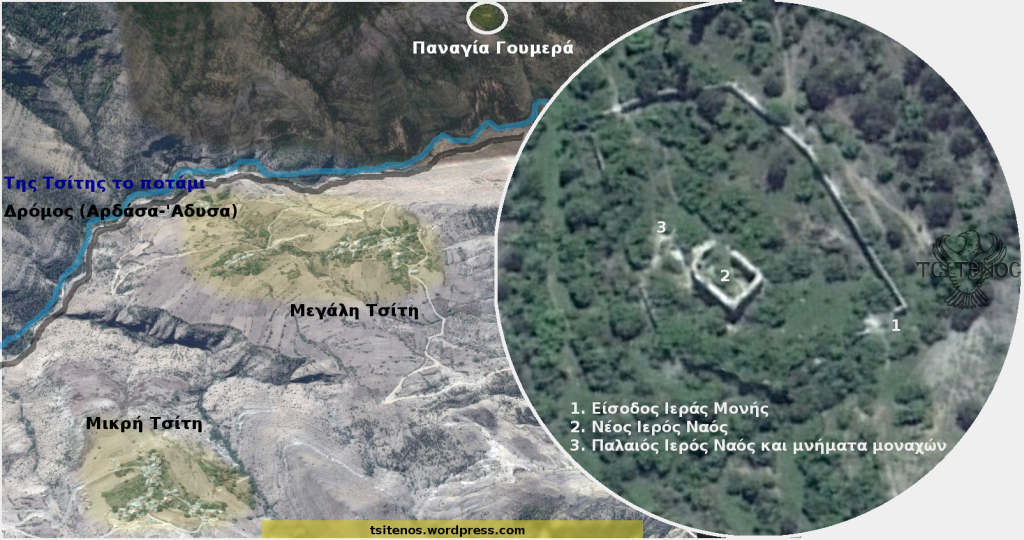
“Chaldia” was the name of the famous “thema” of the Greek (Byzantine) empire in the imperial times and mainly from the 8th century onwards, which had Trabzon as its capital and occupied the entire eastern and central part of Pontus. The ‘themata’ were large mobile military units. When they acquired a permanent establishment, they were named after the area of their establishment.
The thema of Chaldea played a very important role in the defense of the Greek (Byzantine) state, in the constant threat of the enemies from the east. In the wars against these invaders, Persians, Armenians, Turkmens and Turks later, the army chiefs were native dukes and generals of Chaldea as were the warriors. Dependence on the central government of the empire lasted until the 11th century, when the ambitious dukes and generals of Chaldea slowly began to secede from the distant capital. In the meantime, the predominance of the Seljuk Turks and the Sultanate of Ikonio, interrupted almost all communications between the eastern provinces and Constantinople.
Alexios Komnenos created the empire of Trabzon after the fall of Constantinople to the Western Crusaders in 1204 Alexios encouraged the cultivation of Greek letters in Pontus and Chaldea. Enemy wars and raids in remote areas were ongoing. In the locks of Chaldia, the Akrites played their historical role and during that time the acritic songs and the epic of Digenis Akritas were created.
Chaldia is also referred to as the homeland of the Ipsilantis and Mourouzis people and other Greek lords, who in Trabzon initially, later in Constantinople and then in Hungary as rulers, played a historical role and influenced our national affairs.
The occupation of Trabzon by Mohammed II means the end of the Trebizond empire but not the disappearance of the Greek element. A century later, and especially from the middle of the 16th century, the inhabitants of Chaldea began to deal with the rich mines of their mountainous region. The exploitation of the mines of the area has been known since antiquity and the area as Alyvi refers to Homer (Iliad, rhapsody II). We also find a reference to Strabo and the “Ascent of Kyros” by Xenophon. These mines, depending on the general conditions and political events, sometimes flourished and sometimes were abandoned.
The full exploitation of the silver, lead and copper mines from the 16th century onwards enables the inhabitants (Greek population) to extract special privileges from the Turkish Sultan. The Greek population of the area enjoyed the right to protection of life and property. The metallurgists manage to be a privileged class, and the Sultan gave the position of chief metallurgist only to a Greek, and his seat was always in Kani, which was later named Argyroupoli (Silver City). Kani (Argyroupoli) was the only area that had the right to mint its own silver coins.
The wealth of the inhabitants enables great economic and spiritual development of the area. Chief metallurgists live as lords but offer generously for the ecclesiastical and educational needs of Christians. They donate to temples, monasteries, and schools and become true benefactors of the nation.
The prosperity and well being of the Greeks of Chaldea lasted more than two centuries. Financial decline was only inevitable, after the depletion of the mines, which, however, did not affect negatively the spiritual and ecclesiastical development of this mountainous area of Pontus.
This is in general the historical journey of the area that enabled the holy monastery of Panagia Goumera in Pontos, to reach such prosperity and brilliance in difficult, historically, periods.
Panagia Goumera in Pontus
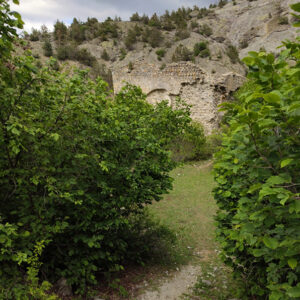
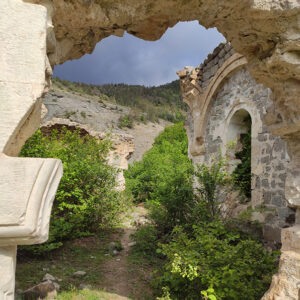
South of Trabzon, Ioannis Avramantis tells us, and at a distance of 92 km. on the road to Erzurum there is the city of Toroul or formerly called Ardassa, which was formerly known as Mesochaldio. This is the seat of the sub-administration (kaimakamliki) of the administration of Argyroupoli (Guimushane) from which it is 25 km away.
The river Kanis passes through Ardassa, in which the rivers Mouzainas, Haravas and Kromnis contribute from the right, and from the left Nivainas, Tsitis, Ryakiou and Tzizeras, which flows into the Black Sea near Tripoli in the location of Halkovala.
The junction of the river Tsiti (Jit dere) takes place 500 meters outside Ardassa near the road to Erzurum, in a gorge that forms a hill on the right with the ruins of an old imperial building and on the left a high and steep rock called Castel.
The river Tsiti has its springs on the highest mountain in the area, Aen Pavlon with a height of 3,080 meters. From there one can see up to the Black Sea. On the left bank of the river there are the villages of Avliana, Sarpiskia, Mavrena, Maklel, Pivera, Tsite, Xopolanton and Simprika. On the right bank is Adyssa. In the middle now of the 6-hour route Avliana – Ardassa and at a distance of 5 km. from it, there is the long-standing monastery of Panagia ( tis Goumeras. Goumera belonged to the community of Tsiti, and this is the reason why the monastery is not known as “Panagia Goumera”, but as “Virgin/Panagia of Tsiti”.
The holy monastery of Panagia Goumera was one of the five holy monasteries of the ecclesiastical province of Chaldia – Kerasuntos and Cheriani of Pontus and is honored on the birthday of the Blessed Virgin Mary. The monastery is located on Mount Pitis or Sidis, located opposite the villages of Tsiti in the province of Chaldia, six hours from Argyroupoli. The holy monastery is built on a huge and flat pit on the rocky side of the mountain and in front of it as a kind of platform there is a narrow piece of flat ground called the “rakan”.
The location of the monastery on the slope of the mountain Aen Kirikas is unique and imposing. Even the ancient fairies, the Druids, would envy it. It is built on a rock in a huge flat hollow of the mountain, and is defined by land and a bright forest. A built-in support in front of the entrance of the monastery used to stretch out to the edge of the rock, like a platform. Under the roots of the mountain flows the river of Tsiti, which descended from the area of Aen-Kyrka. The river is a tributary of the river Kaneos and joins it outside Ardassa.
There are endless mountain ranges with high snow-capped peaks that create small and large rivers that crossed narrow valleys. There is a gorge overgrown at the back of a steep and high rock in the shape of a pyramid which is the “Aen K’ir ka”. And there on the highest peak of the rock stands the windswept chapel of St. Kirikas as an observatory, from where the saint as a faithful national guard supervised and protected the whole area, from Aen Pavlon and the Kaganas plateau to Thehi and Zygana. There are not any plains. The whole area was a natural breakwater, which in the barbaric raids was used by the Greek Empire, fortifying every strategic point of the area. Because of this, there were castles everywhere. The area around the monastery was overgrown with fruit trees, large filbert trees, beautiful gardens and adorned with numerous white and green fragrant flowers.
The monastery of Panagia had a fortified appearance and construction and was surrounded by a strong double wall on the north-east side. On the other sides which were inaccessible and steep due to the sharp section of the rock, the wall was single. The NE wall was 4 meters high, was built of stone and protected the tree plantations and vegetable crops. The inner wall, which was intended to protect and guard the monastery against the invaders, was 15 meters high. Behind the walls, however, religious serenity emerged, offering love to man, to the traveler, to the sick, of whatever nationality they were.
The entrance to the monastery was through the big gate, which was made of thick wood and was lined with iron. Before the entrance there was a large courtyard with a huge walnut tree, where dances and celebrations took place. To the right of the entrance were the guesthouses for the pilgrims.
On the left was the new abbey, which was used as the building of the Goumara High School. There were two two-storey complexes which served as cells for the monks, which housed 15-20 people. The cells were built with the classic monastery art and layout, with balconies supported on vertical sloping stakes overlooking the void. . The buildings continued in a circle with many cells for the monks and the guests. Inside were the abbot’s hall, the kitchen, the bakery, the stables, and the dining room with a capacity for 50 people at the same time. There was also a large guesthouse consisting of 4 large halls which served as the first faculty of the Lyceum.
In the inner precinct of the monastery there were two churches. First, the so-called “little Virgin” was built, dedicated to the Nativity of the Virgin Mary. According to the testimony of N. Loukas, an inscription on a door was preserved until 1903, which confirmed the monastery had been constructed a thousand years ago. To the right of the church there was a stone-built fountain with an artistic façade and plenty of cool water. Farther left in the background was the two-storey old abbey, built with brilliant architecture. The church of the Nativity of the Virgin Mary had a sculpted iconostasis that was decorated with a wealth of mustard and silver investments. The mustard is the inner surface of the pearl shells that was used to make decorative objects. In the basement of the church there was the ossuary, and outside the altar was placed the elegant stone cenotaph of the Metropolitan of Chaldia, Sylvester II, and Agathonikos Papadopoulou who was a priest from Adissos and a teacher.
The great church of the Assumption of the Virgin Mary was built later, around 1830, in the center of the monastery. It was of Byzantine style with a spacious and multi-column narthex. It was brilliantly decorated by the donations of the Stapassids of Tsiti, Sopi and Sirpila and boasted six despotic images of exceptional painting and luxury, works of rare art and craftmanship, unique in Pontos, which were donated by Ananias Kouzanos from Wallachia of Tsitis. On the right inner side of the temple there were the library and the archive, and the heirloom in a hiding place.
The new church did not have a bell tower, the four Russian-made bells hung under the left side of the large narthex. The largest of the bells was called ‘the king of bells’, because it must have been the largest in the whole of Pontos. It is said that two children from Tsiti buried it in a hidden place. Never found again.
The sculptural iconostasis was decorated with a wealth of mustard and silver lining. Its six Despotic icons, rare works of art unique to Pontus, were donated by Ananias Kouzanou, originated from Tsiti but lived in Vlahia. These icons were: of our Lord Jesus Christ, of the honorable Forerunner, of the apostles Peter, Paul and Ananias, of the Birth of the Virgin Mary, of St. Juliet, of St. Kirikos and of St. Paraskevi.
According to Georgios T. Kandilaptis, Ananias Adamidis Kouzanos, the “Law Officer”, dedicated in 1816 thirteen Despotic Icons, with the inscription “Ananias Adamidis Kouzanos, commissioner of the holy monastery in the year 1816 May 29”. There were 6 large icons (probably these were on the iconostasis), 6 small and 1 for the shrine. The depictions of the icons were as mentioned above and that of the shrine was the Nativity of the Virgin Mary. According to Ioannis Avramantis, the icons were painted on canvas. It is said that the image of the Nativity of the Virgin Mary which was in shrine, was found in the hands of a farmer and was later bought by the fraternity of the Pontic Greeks of Kallithea.
All those who got involved with the Goumera of Pontus and described the activities of the monastery there, praised warmly the great feast on the day of the Assumption of Mary, on the 15th of August. On that day, the Greeks and Turks together celebrated “Meiramana”, as the Turks called it, Maria the Mother. All the inhabitants of the area, every man of every religion celebrated together, danced, ate and drank together.
Many of the valuable relics were kept in the monastery’s heirloom, which were stolen in the last robbery raids. At the time of the fall there were only the following valuables, such as artistic icons, sculpted wooden crosses adorned with silver and precious stones, a silver vessel of sanctification, silver carved chalice, silk and heavy embroidered vestments and covers, a Gospel coated with silver gilded (1793 Venice editions) which were donated by Metropolitan Sophronius; also a miter of his own, and another by Sophronius of Ahtalia, richly decorated with excellent fine art and six Despotic icons silver halos and many more.
All this was unfortunately looted after the exchange of populations in 1923 when the monastery was completely deserted. The library was located on the right side of the temple, as was the archive with old codes. The library included many manuscripts and books by ancient writers and church fathers, various ecclesiastical books, many manuscripts of 18th and 19th century music, the series of works by John Chrysostom and a rare manuscript by Aristotle, which was stolen by Minas Minaidis together with other valuable documents from other monasteries of Pontus on behalf of the Library of Paris. Nothing from the library was rescued.
In the monastery there was a manuscript gospel on a 15th century membrane, the most important heirloom of the monastery. Unfortunately it was lost during the war.
Besides, the monastery had been looted by smugglers in the past. There was also another 18th century Gospel which was donated by the patriarch of Jerusalem to the holy monastery in very good condition, written on a membrane. The gospel was saved, transported to Greece and Theophylaktos Theofylaktou handed it over to the church of Agios Dimitrios in Thessaloniki for safekeeping. The blessed Metropolitan of Thessaloniki Gennadios signed the minutes of receipt. This gospel was kept for many years in the fraternity of the Pontians in Kallithea, until 2013 when it was delivered with an official document to the metropolis of Sidirokastro and is available in the holy monastery for the worship of the faithful in festivities.
The biggest religious festival in all of Tolur (Mesochaldia) used to take place in Panagia Goumera, although it was better known as “Panaian of Tsites”. A crowd of people from all over the region gathered during the short Lent of the 15th of August. Even the Turks rejoiced waiting for the miracle of Meriam, celebrating on drums and dancing fraternally with the Greeks. Entire phalanxes of men, women and children, all dressed in their festive clothes, walked all the way from their place to the monastery. Others came from Avliana and Hopsan passing through the villages of Sarpiskia, Mavrena and Adyssa. Others from Tsolochena, Lampadion, Korkota and Haviana. Still others from Sarandar, Macera, Apricadon and Coronix. And others from Riaki, Mourtsani, Paleochori, Tsimbrika, Zermouda, Demirtzikioi and Ardassa. As from Loria, Fourfoura and Lykorrach.
Phalanxes from various villages passing by filled with songs and rifle all the places there. Mountains, ravines and gorges were filled with incessant mud. The area of the monastery is very picturesque. Built on the isoma of a high and steep rock and in the depths of a small valley, it is surrounded by a forest of hazelnuts, poplars and at a higher altitude, pines. Every time a phalanx approached the monastery, the bells would ring loudly as if welcoming them. Each village had its own place for accommodation at the hostel.
The vespers, vigils, Divine Liturgy, large services, and dance festivities with songs took place just outside the monastery gate, under the large dense walnut tree, in a large area especially designated for festive events. There, relatives and friends would meet, exchange news, jokes, gossip and all the beautiful and human interactions. Turks and Greeks would celebrate together like brothers and sisters, children of one same God.
This is how peaceful and always happy life flowed in that happy part of Mesochaldia which bragged the most famous festivities in the whole region until the tragic moment in 1922 when an unimaginable windstorm arose and swept away everything.
The holy monastery after the Asia Minor catastrophe was deserted, looted, destroyed, and today only a few ruins remain. Lazaros Papadopoulos from Adyssa, found those ruins when he went to worship his father’s grave and describes poetically his grief over its demise:
«At Panagia of Goumeras, the candelabra went out
And the candles went out
Bells no longer ring
Chanters there don’t chant the Virgin Mary in August.
Neither monks or abbots do the sign of the cross
Neither festivals and celebrations in memory of Panagia.
The monastery was orphaned, the cells were broken
And the well ran out, too.
All Christians fled
And the tombs also stayed empty
Without a trishagio without a candelabra.
Now spiders wieve nets in the monastery
And the cells became nests in bats.
The owl’s voice mourns at night,
at Goumeras the Panagian as a desert, as tsolia
There are no historically confirmed facts referring to the original foundation, operation and life of the holy monastery. According to Georgios T. Kandilaptis, the written monument of the monastery was an old codex, which was unfortunately lost, it is unknown how and when. Therefore today we are forced to declare that the history of the monastery until the 17th century remains unknown. Legends, testimonies and traditions weave its ancient history. Something that Byzantine scholar Anthony Applemore Mornington Bryer mentions in response to a letter from Ioannis Avramantis:
“…I have not been able to find concrete historical evidence with the history of the monastery before the 17th and 18th centuries.”
The foundation of the monastery dates back to the time of the emperors of Trabzon. From the personal testimony of the traveler Loukas P. Nikolaou who saw an inscription on the small church in 1904, the date of construction is placed at 906 according to Ioannis Avramantis. George Th. Kandilaptis mentions that on the lintel of the church of the Assumption there was the date 950, but it was not saved because “out of ignorance of the monks it was covered in lime”.
The founders are said to be three monks, Sophronios, Paisios and Lavrentios, originating from the village of Housili in the ecclesiastical province of Theodosioupolis (Erzurum). They are also said to be the ones who built the church. These fathers were researching areas for a suitable place for a solitary ascetic life, they saw in their dream the specific location in Goumera and so they came and settled in the area of the later monastery of Panagia. After a stay of fourteen years, they were forced to leave it due to robberies and returned a year later until the end of their lives. It seems that after their death the monastery was deserted for 200 years.
Pantelis Melanofrydis mentions a tradition which he himself heard from educated elders of the village of Adysi. Behind the hill called “o Tsilevas” on the southern and steep stony side of the mountain “T ‘Adianou to podar”, which separates the areas of Adysis – Tsitis, the ruins of a Byzantine temple are preserved. The north side is almost entirely covered with frescoes. The monastery was later deserted due to a landslide. They called her “The Virgin Mary” or “Olisman” from the landslide. Every year there was a Prayer to the Virgin Mary on the feast of the Life-Giving Spring.
So the tradition of the village says that the fathers of the ruined monastery, which had been founded during the 4th or 5th century, went to the location opposite Tsiti which was called “T ‘Igoumera” after the owner of Igoumera, and founded new monastery. It is noted that until today the area above the monastery is called by the the people of Tsiti and the monks “Igoumera”. Hence the name of the monastery “T ‘Igoumera to monastir”, or simply “Goumera”.
In 1150, according to tradition, two brothers, Ananias and Kosmas, from Siehtormi in Theodosioupolis, went to the deserted monastery, felled the surrounding area and built cells for themselves and the pilgrims. Since then the life of the monastery has been undisturbed thanks to the protection of the Dukes of Chaldia, the Klisurachs of the empire, and the emperors of Trabzon. Based on this, it emerged as one of the most important monasteries of the Chaldean theme. The emperor of Trebizond, Alexios III, is said to have re-established the church, which had been destroyed by fire, and to ratify its spiritual jurisdiction over Tsitis.
In 1808 the Ecumenical Patriarchate recognized the holy monastery as Stavropegian monastery with a sigil, as well as all the other Monasteries of Chaldia. The conversion of the monastery into a Stavropegian one one was ratified by a verat in the same year, 1808, by Sultan Mahmut II, the so-called reformer. The permission to build churches was given through another veratio and then “the new majestic church of the monastery was erected, in the memory of Genesis of Theomitoros”.
In 1827, with a second sigil, the Ecumenical Patriarchate restored the monastery to the status of a priory parish, under the direct supervision and control of Metropolitan of Chaldia. During the time of the chief metallurgists, the monastery benefited many times from them.
The following villages were under the spiritual influence of the monastery: Avliana, Sarpiskia, Mavrena, Adisa, Tsite, Exopolandon, Rak, Palaichor, Tsimpika, Haviana, Korkota, Lampadion, Hopsa, Fytiana, Koronixa, Abriwan, Kiberik, Abricun Tsolochaina. The villages of Zarmouda, Lykorrah, Fourfoura and Loria, although Muslim, respected the monastery and benefited from it. According to Theophylaktos Theofylaktos, the village of Exopolanton is Mikri Tsiti, Rak to Ryak and does not include the settlements of Tsiti, Maklel which was a purely Muslim settlement and Pivera which was inhabited by Christians and is no longer inhabited.
Although the monastery was looted many times, making the life of the monks irregular, it was often renewed by monks. Tsiti, Phytiana, Adyssa, Haviana, Varenou and Koronixa are the solid joints of the monastery. It played the role of an important refuge of education, virtue and literature and contributed to the spread of Hellenism.
According to Pantelis Melanofrydis, the monks of the monastery said that around the end of the 17th or early 18th century the monastery was deserted due to robberies and the monks sought refuge in the monastery of St. George Peristereotis where they remained for an unknown period of time. When calm was restored, the monks of St. George supplied them with clothing, vestments and manuscript church books and returned to Panagia Goumera. Continuing, P. Melanofrydis writes that he was allowed by the abbot Gervasios to search the church cupboard, where he found many manuscripts of the 16th and 14th centuries with “elegant and solid binding -calligraphic with beautiful miniatures in the initial capital letters, especially music manuscripts with the inscription: Estate of the Monastery of Agios Georgios Peristereotas “.
The Stavropegian monastery of Panagia Goumera, the “secret school” of Mesochaldio Argyroupoli of Pontus, played a historical and national-religious role, supplying the entire region of Chaldia with monks, priests, teachers and chanters. When the rich subsoil of the region dazzled the Turkish conqueror, he granted many privileges to the Greek miners. The Turk could not have imagined that the mine was to play the role of the secret school together with the monastery, thus creating its dual existence. Every corner of the East experienced the immense nationally beneficial influence of this dual secret school. They met the missionaries of the monastery of all ranks, the monk, the deacon, the pope and the despot, but also the diggers of the mine, the miner and this Chief Metalworker. The former, the clergy, constituted the spiritual power and the latter the economic power throughout the province of Chaldea. An indisputable testimony of this fact is that from 1756 to 1863 Tsiti, a village with 140 Greek families and 30 Turkish ones, ruled metropolitans in Chaldea. Even though, at the time Argyroupoli had more than 50,000 inhabitants. The National Resistance consolidated the salvation of the Nation in the coupling of these two forces of our race, the spiritual and the material and magnified it.
Apart from that, we have only later testimonies from prominent Pontians who were lucky enough to see and experience the holy monastery in its heyday or visited it later, after its desolation that followed the exchange of populations, after the Asia Minor catastrophe.
The book of G. Kandilaptis-P. Melanofrydi and L. Lazaridi “History of the holy monastery of Panagia Goumera” was based on these testimonies, as well as on their own personal testimonies and was later completed by Ioannis Avramatis. So we have the testimony for the historiography of the inscription, which was witnessed at the doors of its smallest and oldest church, which led P. Melanofrydis, teacher of the included Lyceum of the monastery, to confirm its construction a thousand years ago from 1903. It was built as mentioned before by the monks Sofronios, Lavrentios, Paisios on a stony and sloping edge of Mount Tsitis where it took its name from the owner of the area “Igoumeras”. Thus, “the Igoumera the monastery” became “Panagia Goumera” in time.
The holy monastery of Panagia in Pontos was a nursery for both ecclesiastical and encyclopedic education and during the years of slavery, it played the role of a secret school. The monastery supplied its province with monks, priests, singers and teachers and came to establish, in 1913, a Lyceum for higher education, which unfortunately ceased to function two years later due to the First World War. The offering of love to neighbour with food and medical care was daily, as it was a refuge for both wandering and persecuted Christians as well as Muslims and Armenians.
According to Melanofrydis, the abbot of Goumera, who passed away in 1896, was called Iakovos and was active, tall with an imposing stature and respectable. Melanofrydis used to visit the monastery often; once when he was young he went with his grandfather, Archimandrite Agathangelos, on the feast of the 15th of August. Metropolitan Gervasios was also present there. Then the abbot Iakovos took little Melanofrydis by the hand and took him to his special cupboard, where he filled his top with many fillets. He then had the honor of sitting with his grandfather at the despotic table. James was highly esteemed by the metropolitan, by the fathers of the monastery and by the people of God. He did many works, such as the new diocese, and brought order and discipline among the monks.
At the beginning of the First World War, the Turkish government confiscated all the movable property of the monastery, in order to equip the military hospital in Ardassa. The property consisted of brand new bedding for 50 people and as many for the monks and guests. Cooking utensils, dilava large cauldrons, brass, pots, pans, phaetra, sagania, shinia, koukoumia and others weighing 100 okadas. That was when the millennial life of Goumera ended, as well as its newly established Lyceum.
Melanofrydis lists the names of the fathers of the last twenty years of Goumera. Gervasios Lazaridis, Theofilos Garapatzach, Theofanis Papadopoulos, Hilarion Gialamas from Tsiti, Ieremias Melanofrydis, Ioannikios from Adyssa, Panaretos from Avliana, Samuel from Vartanton, Theoklitos from Tzimera, Nikandros from Sarandar, Dionisios Persopoulos from Agrinia, , Polikarpos from the mine Espe, Methodios Iggilizis from Motsera and Iakovos Tsaousis from Hopsa. All the fathers were monks except Methodius.
The Lyceum of Goumera
Goumera in Pontos was and functioned as a nursery for ecclesiastical and encyclopedic education in general. And during the times of slavery it played the role of a secret school. The monastery supplied the province with monks, priests, singers and teachers, and it even founded a Lyceum for higher education in 1913. Goumera High School operated in 1913 and 1914 and beyond, until World War I began. The animator of the idea and the pioneer of the founding of the Lyceum was the late Theofylaktos Theofylaktos. Let’s have a look on how he narrates the facts himself in the following source:
“During the summer at my village (1910) while supervising the schools of the river Tsitis with the well-known friends and associates, we started to put into action the issue of the Central School in the monastery of Goumera. And we thought a lot how to guard against the reaction of the monks, of whom few understood the reason for that. And the metropolis should be advised beforehand not to fight our plan. And that was necessary for many reasons. The metropolis would cover the legal pursuit. The Turkish authorities could not intervene even if someone wayward was thinking of going there. Privileges still applied.
A little late, on the occasion of the 15th of August (1913) of the festival in the monastery of Goumera, we organized a ‘National memorial of all the surrounding villages in memory of national martyrs. I spoke at the memorial service from the door of the abbey, which overlooked the huge courtyard that was flooded with people. After the speech, I gathered the lords of the villages – they were representatives with a power of attorney, who came at our invitation – and we held the first founding assembly, which decided to establish the School. We also named it “Goumera High School”. We also named it “Goumera High School”. We also appointed a committee.
We put representatives from the villages in this committee. Tsiti representatives along with me were: Dimitrios Georgiadis and Christos Prokopidis, merchants in Ardassa. Siamis of Adyssa with Elian Melanofrydin. Papliania of Avliana, Georgios Putachidis of Javiana, merchant in Ardassa. These were the powerful that would resist any dissent against the work. Some of them had children who were studying in Trabzon and could be candidates for teachers at the School. . And so, bypassing the narrow meaning of the previous decision of the metropolis, we implemented our own plan, that is, we founded the School inside the monastery and used the new abbey as a doctorate, which was very suitable. With the cooperation of all, the Lyceum operated in 1913 and 1914 and a little further, until the first Great War broke out and swept everything and in the end it uprooted us as well “.
Panagia Goumera in Greece
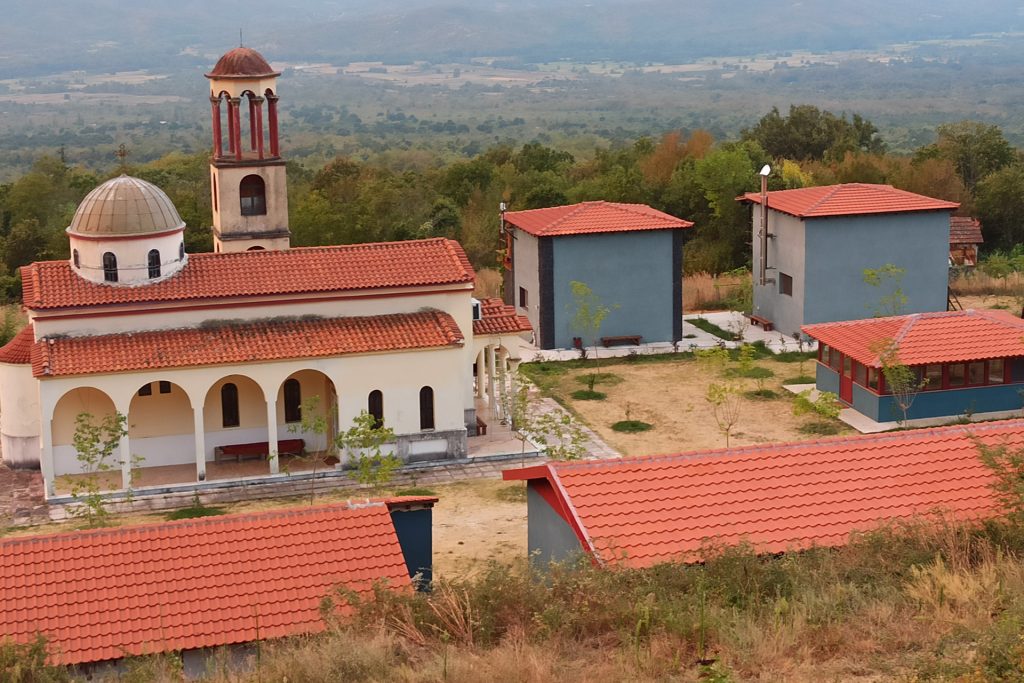
The popular teacher Ioannis A. Avramantis, incurably nostalgic for the greatness of the Hellenism of the east, as he himself mentions, had the initiative to establish in 1966 in Kallithea, Attica, a Pontian association under the name “Panagia Goumera”. Members of the union were the descendants of the Pontian brothers from Mesochaldi but living in Athens and Piraeus. The main purpose of the association was to revive and preserve the ecclesiastical and national traditions of the birthplace in Pontus. Avramantis was born in Tsiti in 1890.
The president of the newly formed Association was Avramantis himself, the vice president Kallles, the secretary Papalazaridis. Advisors were Akritidis, Anastasiadis, Andreadis, Siopidis, Tiftikidis, Chrimatopoulos, Efstasiadis, Kladas and Papadopoulos.
Shortly afterwards, it was decided to open the Goumera monastery in Greece. The secretary of the association, Mr. Tsenidis, a teacher from Sarandar of Pontus, took the inspiration and the initiative of the story. As a result, the place on Mount Belles in the village of Makrynitsa in the prefecture of Serres was proposed. The union of the Pontians sent a memorandum to the most revered metropolitan of Sidirokastro, Ioannis, asking him to allow them the restoration of the holy monastery in his own ecclesiastical province.
Ioannis Tsenidis was for a while a popular teacher in the community of Makrinitsa. Refugees from the area of Chaldia settled in Makrinitsa. According to his personal written testimony, in the summer of 1970, while visiting dear friends in the village, he came up with the idea of setting up the Goumera monastery there in the area of the village, a little higher at the foot of Mount Belles. The then president of the community, Ioannis Theodoridis, immediately agreed. Without a doubt, all those in charge and the residents of Makrynitsa mobilized to make it happen. Then in Athens, Tsenidis informed the administration of the Pontian union and after a unanimous agreement, it was decided to go with the president of Makrinitsa to the metropolis of Sidirokastro. There they handed over a memorandum to Metropolitan Ioannis who embraced the idea and did what was necessary to achieve this sacred purpose.
In Makrinitsa, Divine Providence enlightened Mrs. Athanasia Titarou, widow of Ioannis Titaros, and donated a plot of 35 acres for this noble work. Along with her, Mrs. Vetta Kanli donated another 5 acres. In his book, Socrates Kladas mentions that Mrs. Kanli also donated property suitable for the construction of the holy monastery. However, because the holy monastery did not yet exist as a legal entity, this donation was offered to the committee of the holy church of Panagia Makrinitsa for a short time until the holy monastery was designated as a legal entity. Unfortunately somewhere along the way everything was lost and today none of these plots exist as property of the monastery.
According to an article by Avramantis and Tsenidis, on June 6, the feast of Pentecost 1971, the holy church of the holy monastery of Panagia Goumera in Makrynitsa was founded, which is honored in the memory of the birth of the Virgin Mary. The ecclesiastical ceremony was attended by numerous people, all the authorities, ecclesiastical, political, administrative and many unions. Festive speeches were delivered by Lazaros Papadopoulos and by the professor of theology Agathangelos Agathangelidis from Avliana. On September 12, 1971, Metropolitan Ioannis performed the first divine service in the sanctuary of Goumera, collaborating with Metropolitan of Polyani and Kilkis, Chariton.
The new church of Panagia Goumera was designated as a “Holy Monastery” by decision of the Church of Greece, after a written proposal of the Metropolitan of Sidirokastro, Ioannis, on 9-1-1971. Later, on 19-2-1971, the Holy Synod of the Church of Greece, presided over by the Metropolitan of Athens Ieronymos, in a letter to the Ministry of National Education and Religions, requested the issuance of a relevant Royal Decree on the establishment of the Holy Monastery of Panagia Goumera. The Greek government, reigning Constantine, on 3-5-1971 by Royal Decree decides the establishment of the holy monastery of the holy metropolis of Sidirokastro.
In 1971, with the foundation of the church of Panagia, the vision of the Pontian brothers began to take on flesh and blood. Memories, expectations, emotions. The administration of the association envisioned not just a convent of priests and monks, but a spiritual, social, national center. Everything for the faith and the homeland, through the culture and traditions of the people. They envisioned building not only a church in memory of the birth of the Virgin, cells for monks, a small house, a dining room, a kitchen, places of worship, gardens, orchards, various crops, for the holy monastery itself. But also houses that will host activities such as organizing training seminars, teaching Byzantine music and promoting cantors, organizing lectures of religious, cultural and national character. A library building and folklore museum. As well as hostels for the hospitality of pilgrims and visitors who would come from afar as well as those who were engaged in all these pious works. These people wanted to put their whole soul into being.
Unfortunately, things in Goumera did not develop according to the good wishes of the Pontian union. Various difficulties, mainly financial, prevented the continuation of the project. The main reason, however, was the fact that in the next generation of the union’s management, the intellectual and competitive wisdom was absent; the philanthropy of the uprooted Greek Pontius was absent. The removal from the roots, the weakening of the empirical memory of the uprooting difficulties, the economic and social rehabilitation in the Greek society, the prosperity, and the care of life as well as the long distance of Kallithea from Makrinitsa, gradually removed them from their homeland ideals of the protagonists.
And as it happens in these cases, the secular wisdom, in the end, prevailed over the spiritual, with the consequence that in the name of the Virgin Mary and her monastery, selfish thoughts, orientations and exploitations begin to emerge and take place. In fact, at a point where even today, when these lines are written, the Pontian association of Kallithea, is completely indifferent to the fate of the holy monastery and its fathers to say the least.
What was finally achieved was only the construction of a small church, a chapel in essence in a field, which for many years functioned as a pilgrimage church of the association in the area of Makrinitsa. The holy monastery, as a holy monastery, existed only in writing and decisions, as a monastery without property status, without monastic buildings, without fathers and brothers and without monastic property is by no means a monastery.
However, the association of the Pontians visited the monastery, the small church, that is, two to three times a year, where they celebrated their holidays with a truly festive atmosphere and a large crowd, as befits the grace of the Virgin Mary and the love of the faithful.
In December 1973, Socrates Kladas, president of the association of Kallithea, Theocharis Kalles, honorary president of the fraternity, Aristides Kalles, president of the Thessaloniki branch, Grigorios Putahidis, president of the Lavreio branch and “Polychronian Velonas conceived the idea to erect the “House of Haviana” in an area above the church of Panagia.
Haviana is a village in Chaldia, from which many refugees came and settled in Makrinitsa. Socrates Kladas and the others in a letter ask for the financial help of their Pontian brothers for the building of the house in Haviana. Their wish was for this three-storey small building to be used as a folklore museum with everything that exists in their village, but also as a hostel for the people of Haviana. The refugees of Haviana should also have their own house in the area of the holy monastery. Today this small three-storey building belongs to the Pontian association of Kallithea, has nothing to do with the people of Haviana, as well as with the holy monastery.
Kladas literally gave his life for the completion of the holy monastery, as he was killed leaving the monastery during the construction works. Today his body rests in a small space that you use as a cemetery of the association along with two other pioneers and great personalities, the historian Ioannis Avramantis and Aristides Kalle.
Shortly afterwards, in 1976, a small two-room house across from Haviana was completed. The project was undertaken by the Pontian association “Black Sea Club” of the municipality of Serres, under the chairmanship of Mousseidis Periklis and Takounidis Nikolaou. “Serraiko” is the property of the Black Sea Club, which with a delivery agreement handed it over for use to the association of the Pontians of Kallithea for the needs of the association itself and not the holy monastery. The agreement is dated April 1988 and is signed by the president of the Black Sea Club Petros Mavrofrydis and the president of the association of Kallithea Vassilios Seitanidis.
A few years later, in 1988, the administration of the association with Vassilios Seitanidis as president, came to an agreement with the president of the community of Makrinitsa. And as a result the community donated to the union of the Pontians 9 acres of land. A little above the fence wall of the monastery. There the association built a privately owned large hostel, which serves the interests and needs of the association to this day. At the same time, another building of the association is being build to the right of the entrance of the monastery.
A little further in front of the church of Panagia, in 1990 Metropolitan Ioannis laid the foundation stone of a small church, Agia Kyriaki. Athanasios Lolidis, a resident of the village of Pivera in Chaldia, built this small church. Athanasios’s parents were Konstantinos and Kyriaki. e therefore built the church in memory of his parents. Along with the church of Agia Kyriaki, Athanasios also contributed to the expansion and beautification of the church of Panagia. The original building of the church was imperfect, inadequate and poorly made. It needed to be opened immediately to expand, a bell tower to be created, an entrance porch with columns and an external expansion of an open space with a tiled roof and columns. Athanasios Lolidis was an architect and president of the union of the Pontians of the central part of Thessaloniki. Athanasios undertook the drafting of the plans of the buildings in the area of the monastery as well as the supervision of the works.
Of course, the pioneers of the idea of reconstitution and revival of Goumera of Pontus here in Greece, had selfless motives and a burning soul for the faith and the homeland. Like Theofylaktos Theofylaktou, Socrates Kladas, Ioannis Avramantis, Georgios Kandilaptis, Panagiotis Melanofrydis, Athanasios Lolidis, Ioannis Tsenidis, Aristidis Kalles, Theocharis Kallos, and Theocharis Kallos,
However, their successors in the administration of the association did not embrace their divine work and its deep meaning, something that is evident through their own works as is the lack of care and effort for the real reconstruction of the monastery of Panagia. The property status of the monastery contains only the church, nothing else. There aren’t cells for the monks, a little house for the pilgrims or kitchens, dining room, places of residence, warehouses, arable land, etc. etc.
In 2006 the metropolitan of Sidirokastro, Makarios, instated the elderly nun Efimia in the holy monastery. Later in the spring of 2017, the elderly Efimia with two younger sisters and the newly arrived father Barnabas were transferred to Sidirokastro to the holy monastery of Agios Kyrikos and Iouliti.
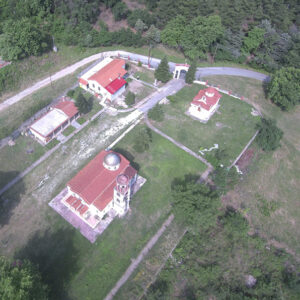
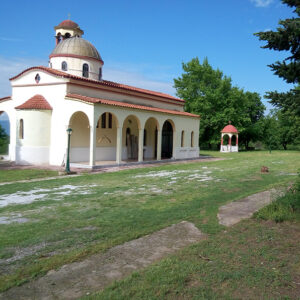
In September 2017, Metropolitan Makarios instated a new abbott in the holy monastery, the monk Bartholomew. Bartholomew consecrated for many years in the holy monastery of Koutloumousi of Mount Athos, where he practiced obedience with indistinguishable love to his holy and beloved Elder Christodoulos.
Bartholomew immediately understood the multifaceted difficulty of the whole endeavor. That is, to settle and establish Goumera as an organized orthodox monastery, just as it existed and operated for a number of centuries in Pontos. The problems are many and varied. The main issue is that the monastery has no income at all, because it has absolutely no property, no land, no building, no mobile property or real estate. The only, one would say, property of the monastery are the two churches, Panagia and Agia Kyriaki, and nothing else. All the efforts and dreams of Ioannis Avramantis and the others went in vain.
Father Bartholomew, immediately went about constructing the first necessary buildings. Tough winters in Goumera though don’t allow the doing of the premises. Waiting hence for the Easter holidays of 2018 to pass, rough-draft places started to be built to temporary house the dining room (trάpeza), the kitchen (mayiriό), the show room (έkthesi) and the reception area (arhontariki) of our monastery. Moreover, the first cells to house fathers begun to be built and they were completed by next summer of 2019 while the rough-draft dining room and the rest of the buildings were completed by 2020 summer time.
As we previously mention Holy Virgin Mary’s convent has no top earner. None so ever. All these projects come to life thanks to layperson contributions. No union, no organization, no constitution ever offered the slightest financial aid for our Holy Virgin Mary’s monastery construction. Simple yet beautiful people watching Father Bartholomew’s persistent and strenuous struggle and cause, rushed out to go in with every possible way for the supreme, sacred cause, namely, he construction of Starenias’ monastery.
In the 2020 summer along with the completion of the rough-draft dining room two more cells to house fathers were completed. During those summer months Father Bartholomew set off a major tour throughout Greece to find the necessary financial means in order for the project to be continued. Having Metropolitis Makarios’ blessings and an official letter by his metropolis Father Bartholomew literally scour our country from Didimotihos to Kalamata. He visited every Metropolis and every friend and acquaintance, even strangers. He was away from his monastery almost for seven months in a row. Shaping words has now become a science.
The following summer of 2021 the church of saint Paisios and saint Porfirios is constructed and along with the church the internal area of the monastery is cleaned and landscaped. In addition, all the surrounding area is cleaned due to fire safety reasons as well as beautification reasons. Later on, in early 2022 started and are completed the big,
official dining room (trάpeza) of the monastery with its kitchen (mayiriό) as well as the reception area (sinodikό or arhontarίki) of the monastery. The previous areas hosting all these, are now used as dohiό, namely, as kitchen pantry, as cloakroom and as a small guest house.
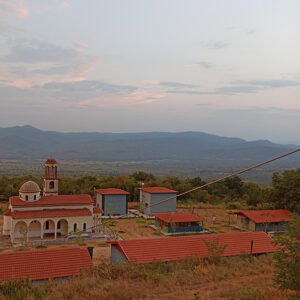
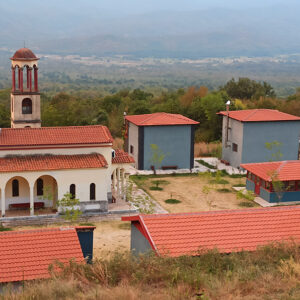
Then in 2023 Spring tree planting starts. Trees for shade and coolness, ornamentals, fruit trees and various flowers, especially red rose bushes. The next necessary project is the restoration and the beautification of the supporting wall of the monastery, as its once rough construction made it weak and unsafe over time. A new entrance is definitely a necessary project as well, as the existing one no longer meets the emerging needs of the monastery and the pilgrims.
Bartholomew of Goumera, immediately realized that they are the next fathers of the Mother Monastery, Goumera of Pontos. The responsibility is huge. A large time gap, 100 years old, is bridged today here, in this place, on the verdant fringes of Belles, on the bloodstained borders of our nation. Fiery Akrites, guardians of faith and homeland. And yet, simple monks, suffering and sinful people, who move and fight daily between, passions and weaknesses, gods and demons, sin and repentance, love and fear, virtue and hell, life and death.
With our hope, in the Love of Starenia, in the blessings of the centuries-old fathers of Goumera who have fallen asleep, the blessing of our metropolitan Makarios, the protection of my holy Elder Christodoulos, and of course the warm love and generous embrace of my spiritual children, the beautiful care of the residents of the area, of our friends and brothers, we really stand here… standing and strong… we persist stubbornly, vigorously… and we move forward… and we will always move forward… AMEN !!!